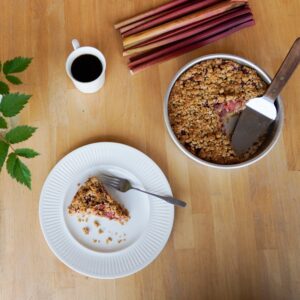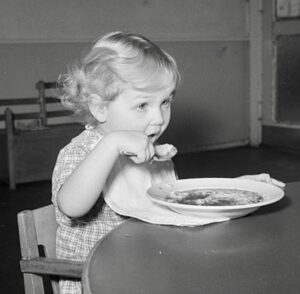
June is the month of Iceland’s National Day (June 17), weddings, and rhubarb. In honor of all three, this month’s recipe is Icelandic Happy Marriage Cake. The Happy Marriage Cake can be summarized as a double-crust rhubarb crisp. That means it’s simple to make, delicious, a bit on the carb-heavy side, and great when shared with a loved one and a cup of coffee. The recipe is also really, really forgiving, so view it as a guideline and feel free to improvise where you will.
Rhubarb’s colorful history
And now, before we launch into the recipe, a few words in appreciation of rhubarb. When we look at this hardy, ubiquitous plant growing alongside garages throughout the Midwest, we think about pies, not caravan serais. However, it was camel caravans, silk merchants, trade centers like Ulaanbaatar and Constantinople, and herbalists in search of better medicines that brought rhubarb from its home in Siberia to Minnesota. Oh, Carl Linnaeus and Benjamin Franklin played vital roles, too.
If rhubarb were a guest on “Finding Your Roots,” it would be gasping each time Henry Louis Gates, Jr. asked it to turn the page.
The plant was prized in Chinese medicine, beginning in the Han period, 206 BC. Chinese physicians believed it cleansed the blood and purified the system. By the 10th century, dried, powdered rhubarb was a hot commodity on the Silk Road trade route. It commanded exorbitant prices each time it exchanged hands along the thousands of miles between China and Greece, Rome, and Iran, where the demand was the highest.
A bit like Enron stock
Its growing reputation as a cure-all made rhubarb powder as valuable as saffron, which still sells for roughly $70 to $200 an ounce for the real stuff. For those of you eyeing your rhubarb patch as a way to make the mortgage – sorry, the bottom fell out of that market centuries ago. Blame savvy merchants and herbalists who began growing the plant themselves. The Kashmir region of Pakistan, with its cool mountain areas, became a rich source of rhubarb. People there incorporated the stems into their food as well as powdering the dried plant. More growers in more regions naturalized rhubarb, bringing down the price and making it accessible to all.
Linnaeus’ proudest achievement
Carl Linnaeus (1707 to 1778) is remembered for creating a taxonomical system for the natural world. Scientists now had uniform names for plants and animals and the his system is still in use today. He was also a Swede who fiercely loved his country and wanted it to be as self-sufficient as possible. He tried growing tea plants so Swedes wouldn’t enrich other countries in their search of a cuppa. He tried domesticating an elk and training it to pull a plow so horses, who have trouble navigating rocky soil and steep hills, wouldn’t be needed. He also introduced rhubarb to Sweden, an act he called his greatest achievement. Swedes responded to his gift with whole-hearted acceptance. They grew rhubarb and created sweet, savory, and medicinal recipes.
This is where Benjamin Franklin makes an appearance

When Swedish immigrants came to America, they found a familiar plant thriving here. Benjamin Franklin obtained “real Siberian rhubarb seeds” while in England. He mailed the seeds to Quaker botanist John Bartram. Bartram, like Linnaeus, was interested in all things botanical and wanted to make rhubarb readily accessible. He grew the seeds, along with other varieties of rhubarb he had obtained. Bartram developed robust strains that he then sold to fellow colonists, settlers from the former New Sweden Colony and to English gardeners. And now the story comes full circle: Swedish botanists, including Carl Linnaeus, took notice. In 1769, they invited Bartram, a non-Swede, to become a member of Sweden’s Royal Academy of Sciences. Rhubarb not only cleansed the blood, it brought honors and prestige. That’s a family story of which rhubarb can be proud.
Bring honors and prestige upon yourself
A few quick notes on the recipe: The filling is essentially a compote. Therefore, it is ideal for rhubarb that isn’t photogenic or isn’t at its fresh-picked best. Add any fruits you think would be good. I found this recipe a great way to use up a smidgen of strawberry jam that was in the fridge. As you cook the rhubarb, you may want to add water. Or orange liqueur. The proportions given in the recipe are a starting point. Make more if you wish, just add a few minutes of in the oven so the crust becomes firm.
Now, make everyone happy, whether married or not, and bake.
Icelandic Happy Marriage Cake
Ingredients
Equipment
Method
- Combine all the ingredients for the rhubarb filling into a saucepan.
- Cook the filling ingredients over medium heat. Add liquid if needed.
- Cook until soft.
- Turn off the heat. Let the rhubarb cook with the residual heat for a few minutes longer, stirring continually.
- Heat the oven to 400 ℉.
- Grease the cake pan, including the sides.
- Combine the oats, flour, sugars, and baking soda in a bowl.
- Mix the ingredients together with your hands or run through a blender if you want a smoother crust.
- Cut the butter into the dry ingredients with two knives. The dough will be lumpy and rustic.
- Gently beat in the egg.
- Take two thirds of the dough and press it firmly into the cake pan, including the sides.
- Pour the cooled filling over the crust.
- Take handfuls of the remaining dough and sprinkle it over the filling.
- Bake for 25 minutes.
- Cool before cutting.

8 ounces butter is 2 sticks – 4 ounces is one stick or 1/2 cup
That line needs fixing
Jan, thank you for catching that! I made the change.
Did you really mean to use an 18” cake pan? I’m not familiar with that size.
Hi, please use one eight-inch cake pan. In some views, there is not a lot of space between the two numbers. I added the word “eight” in the recipe to help clarify. Eighteen inches would be quite a pan indeed! I appreciate you letting me know.
Looks really yummy, but I have a question: Step 6 in the Make the Crust section says, “Gently beat in the egg”, but I don’t see an egg in the list of ingredients for the crust. I would be tempted to just eat the filling with a spoon, but my husband & daughter are fans of crumb crust. Thanks!
Hi Ann, the 1 egg is listed at the very bottom of the ingredient list for the crust. Thanks for asking and let us know if you make this recipe!
Looks delicious and I’m in love with Iceland so I’ll give it a try. I’m thinking of taking it on a weekend away but the person I’m visiting had dental surgery so must be careful. Is the crumble fairly crunchy (like a crisp Cookie) or softer like an apple crisp or streusel topping?
Delicious and tastes like what I had in Iceland. The ginger and cardamom are key to that authentic flavor. Will be making this on repeat!